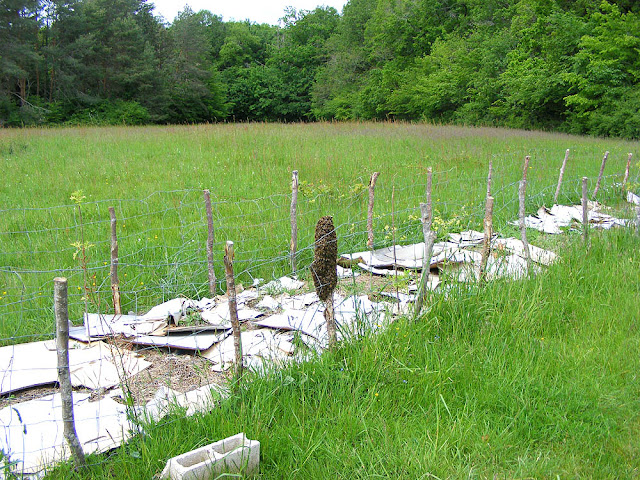May and June is the season for honey bees to swarm. I came across this a couple of weeks ago, and it wasn't the only one I saw on the day. So far this year I've seen four swarms.
Western honey bees Apis mellifera (Fr. abeilles des ruches) swarm when they need to divide a colony in two. The queen, having laid eggs in special queen cups, will then starve herself so she is light enough to fly, and when the moment comes she emerges with half the colony surrounding her and they take a short hop to a nearby perch.
 |
| A swarm resting on a fence post in the middle of a hay meadow surrounded by woodland. |
Then twenty or thirty scouts will head out to find their new home. When the scouts return they will indicate the direction and suitability of the new site by waggle dancing. Usually it takes the bees less than 24 hours to relocate, but sometimes it will be a couple of days. They've gorged themselves in the previous days to tide them over for a couple of days where they don't have anything to eat so they can survive. The biggest risk is a sudden cold snap catching them outdoors or weather preventing them from flying from their temporary perch to their new home. The swarm rarely goes more than a kilometre from where they started.
 |
| A swarm waits for scouts to return. Somewhere under all these bees is the queen but you rarely see her. |
Back at the old hive a new queen will hatch, mate and take over the other half of the colony.
 |
| I think this group of bees will join the swarm. |
Swarming happens in the late spring. The scouts will look for a suitable cavity, with enough capacity (20-40 litres), an entry hole near the base, weatherproof , and getting some sun but not too much. If it has been used by honey bees in the past and already has honeycomb that is a bonus as it saves the new colony some resources.
 |
| A close up of the swarm. In this situation the bees are not aggressive and I had no qualms about getting within a metre or so to take a photo. |
In managed hive colonies apiarists will normally employ one of several techniques to prevent or redirect swarming behaviour. If you have a swarm on your property local apiarists are usually willing to come and collect them. This is the best solution, because left to their own devices they are rather prone to taking up residence in chimneys and other cavities in buildings.
We are also on Instagram, so check us out to see a regularly updated selection of our very best photos. You may also like to check out our YouTube channel.

4 comments:
Just like a broken record, we'll be repeating how amazing nature is!
Very informative post.
Is honey bees swarming a spring thing and happens no matter how many bees there are in the hive?
Or is there some other events that trigger the swarming?
My experience is that homey bees are not aggressive, unless they are disturbed.
We had a swarm take up residence behind a shuttered window of our house about a week ago. The swarm was collected by a local neighbour in the evening when the bees got dozy. Took ages to rid of the smell of the smoke. But it was nice to find a good home for them.
Post a Comment